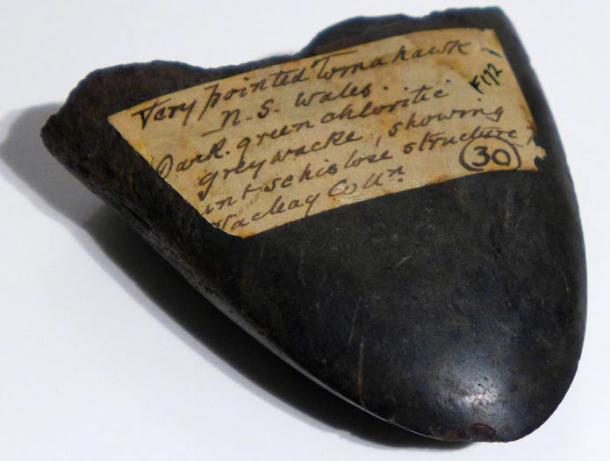
Written in Stone: Neolithic Weapons and Tools of the Australian Aboriginals
The groundswell of interest world-wide in artifacts from our prehistoric past reveals our shared humanity at a time when no written records exist to bear testimony to it.
Indeed, 99% of our history is prehistoric, which leaves a lot of mankind’s developing apprehension of the world and the skills acquired to negotiate it, completely unmapped — except of course for stone tools and implements.
At the University of Sydney, the Macleay Museum has mounted a remarkable exhibition called Written in Stone, curated by Matt Poll, which explores the history and aesthetics of Australian Aboriginal stone artifacts from some 40,000 years ago to the nineteenth century. The presentation of these implements extends their significance from the anthropological and archaeological into the aesthetic realm.
Ancient Occupations
Discoveries which locate Aboriginal habitation of this now desiccated continent from at least 40,000 — perhaps 50,000 years — have concentrated archaeological interest around the globe, especially as this occupation of Australia by successive waves of peoples, precedes any settlements in north and south America by more than 20,000 years. It also places them in a cycle which spans the Pleistocene (two million years to 10,000 years ago) and the Holocene (which dates from the end of the last ice age to now — although some scientists and climatologists are calling for the current times to be named ‘Anthropocene’ in recognition of the impact of fossil fuel use on climate).
- Genetic studies link indigenous peoples in the Amazon and Australasia
- Aboriginal languages could reveal scientific clues to Australia’s unique past
- Australian Aboriginals knew of variable star Betelgeuse before European astronomers
Song Lines: A network of oral history
While the debate continues about how long Aboriginal peoples have inhabited this continent, certain facts are not in dispute. Over the millennia great adaptations were required for changing climatic conditions. The routes (‘song lines’ if you like — and largely inaccessible to the European mindset) which criss-cross the continent like skeins of wool or resemble the pattern of lights on a circuitry board, had both food gathering and ceremonial functions.
Trading patterns where physical resources and new technologies were exchanged, are evident from certain kinds of objects being found thousands of miles from their center of production. One such example is the riji, a mother of pearl shell engraved with geometric patterns and with red ochre rubbed into the grooves. These were worn by men in the far north-west of Australia but have been traded as far as Queensland and South Australia.

Pearl shell ornament with ochred engravings and hair string belts. Australian Museum; Aboriginal Art. Public Domain
Developments in Aboriginal stone — or lithic — technologies over the last 40,000 years are still being debated by archaeologists and new ‘methodologies’ are slowly unfolding with terminologies which differ substantially from those developed in the 19 th century to classify African and European stone artifacts (dating from 2.5 million years ago). So far, the ‘Australian Small Tool Tradition’ remains the most convenient means of encompassing and describing assemblages of various tool types.
Weapons and Tools
Because many of the artifacts, which encompass hatchets, hand axes, ‘waisted’ axes, grindstones, scrapers and microliths have been collected privately over the last two centuries before finding their way into museums around the country, the exact location and circumstances of their production and trade have been lost. Thus, in this exhibition they have been grouped according to the states they were found in. However the viewer will be aware that the creation of state borders was a European notion.
The showcases (with the exception of a group of works titled the ‘Macleay Bequest’ are arranged thus: Western Australia, West coast Arnhem Land, Central Australia, south east Australia, western New South Wales, Greater Sydney and Tasmania. Curiously, Queensland is out of the picture.

Hand-axe fragment.

Waisted hand axe
The various types of stone used to make tools have not, with the exception of quartzite, sandstone and silcrete (a sandstone altered by heat and pressure) been included in the catalogue entries. Yet identification of the type of stone may, in the future, point to the earliest source and manufacture of a tool, just as in Europe it is sometimes possible to trace ancient trade routes by knowing where a particular type of flint was obtained.
- Did Portuguese beat Captain Cook to Australia by 250 years?
- Ancient tools evolved in Australia thousands of years before they appeared in Europe
- Ancient Indigenous Practices of Australia Kept Nature in Harmony
The varieties of rock mined from specific quarries Australia-wide by the Aboriginals is extensive: andesite, basalt, diorite, dolerite, granite, greenstone, greywacke, ironstone, limestone, mudstone, obsidian (volcanic glass) porphyry, quartz, siltstone, trachyte and the aforementioned stones. The most sought after and valued due its special qualities was chert or flint. Nodules of this material could be struck to produce blades and flakes with edges of surgical sharpness.

Wandji blade (back and front)
The ground edge axes and polished axes, which approximate developments across Europe, Asia and America is a refinement of the Neolithic period (approximately 12,000 years ago to 2,500 ago). While the most recent implements on display demonstrate how quickly Aboriginal tool makers adapted their skills to new materials like colorful bottle glass and ceramic telegraph line insulators. This is especially evident in the beautifully proportioned ‘Kimberly Points’ which are characteristic to the Northern Territory.

Kimberley points.
This is a carefully researched and beautifully presented exhibition which will delight everyone interested in Aboriginal culture, whether they be students, archaeologists, geologists, artists or flint-knappers.
Featured image: A Neolithic axe created by the Aboriginals of what is now Australia.
All images, unless otherwise noted, are copyright © Patricia Anderson.
















Comments
Excellent site.